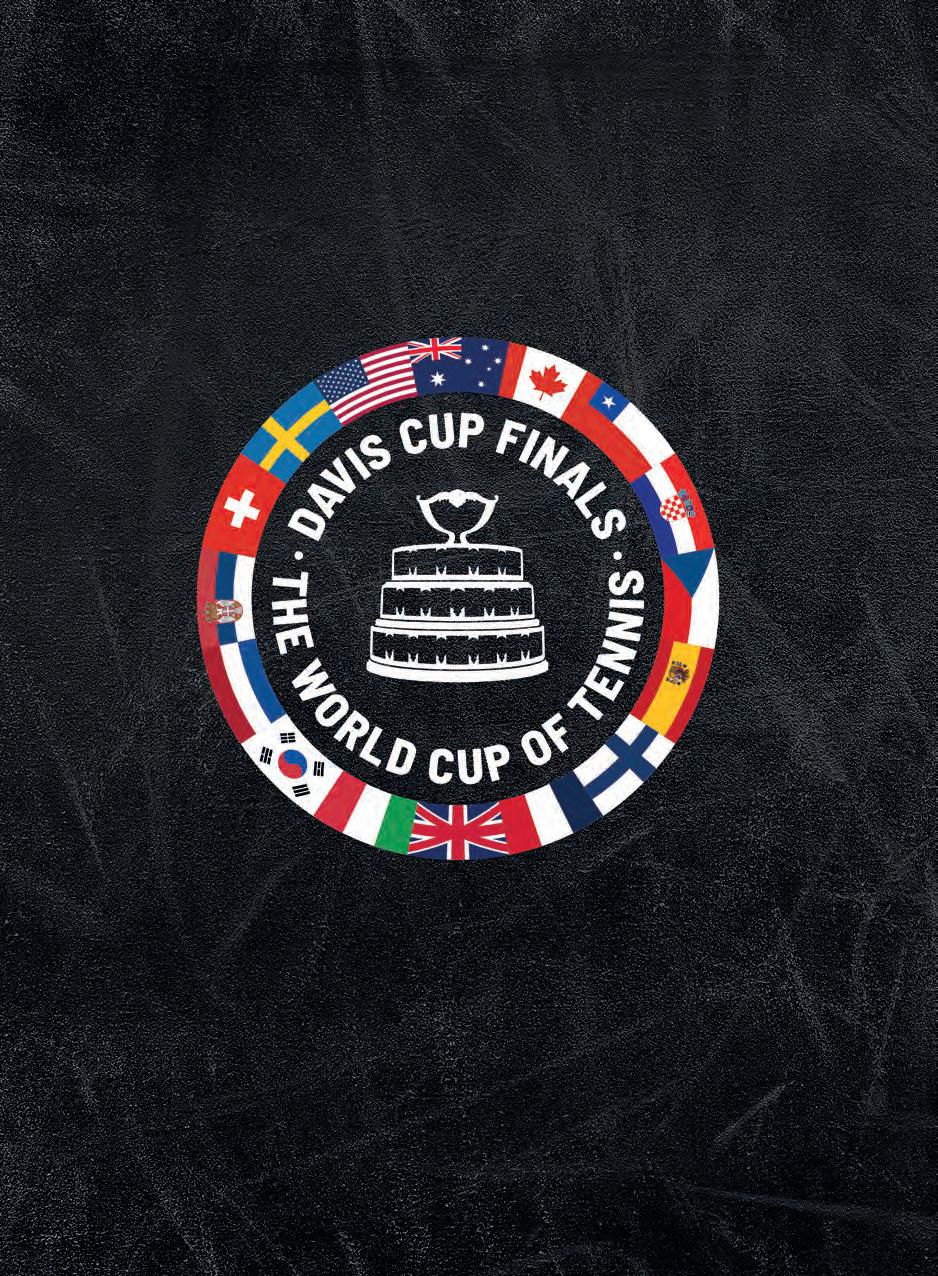














CANADA VS FINLAND
November / Final 8 / Malaga 4:00 PM (CEST) 12:00 PM (CEST) 4:00 PM (CEST) 4:00 PM (CEST) 10:00 AM (CEST) 4:00 PM (CEST) 4:00 PM (CEST)
WINNER QF 1 VS WINNER QF 2
CZECHIA VS AUSTRALIA
NETHERLANDS VS ITALY
WINNER QF 3 VS WINNER QF 4
WINNER SF 1 VS WINNER SF 2
nd rd Tuesday Saturday Friday Sunday Thursday Wednesday Thursday
BRITAIN VS SERBIA
* This schedule is subject to change only in exceptional circumstances. ** The number of the quarter-finals and semi-finals are marked by their positions in the draw.
QUARTER-FINALS SEMI-FINALS

CANADA

Write the winners in the gaps as the tournament progresses!
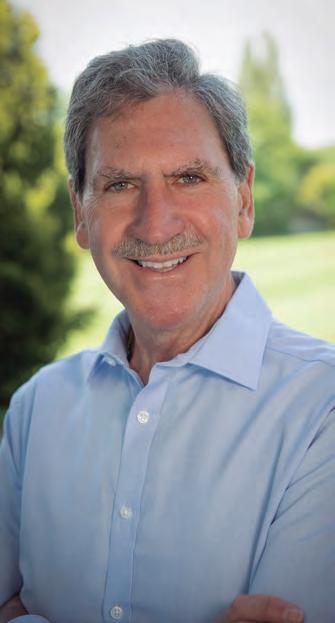
“DAVIS CUP IS AN ESSENTIAL PART OF THE FABRIC OF TENNIS”
Tell us what makes the Davis Cup Final 8 so special?
Over the next six days, we’re going to see this year’s best eight nations in men’s tennis battle to become Davis Cup champions. It’s a pretty rare honour – in the 123-year history of Davis Cup, only 16 nations have lifted the trophy.
That said, Canada were fist-time champions last year, proving that it is possible for new nations to break through. I’m sure that achievement will be on the minds of many of the players here and provide extra motivation and belief to succeed.
For men’s elite tennis, this event is the final act f the 2023 season, and it’s a real test of character for all the players involved. There is an extra pressure that goes with representing your country, but there are big rewards for those that thrive on that pressure.
What are you most looking forward to?
This is the men’s World Cup of Tennis, and the Final 8 promises to be extremely competitive. It won’t be easy for any team, but it will be exciting for all of us watching, either in the stadium, on TV, or following on social media.
After the round robin action of the Davis Cup Group Stage, we’ve reached the
knock-out rounds and the teams get just one shot to advance. Both fans and players are going to see some hard-fought matches over the next few days. It’s going to be very special.
It’s also great to be back in Malaga for this event. I know that as well as superb oncourt action, players and fans will enjoy fantastic Spanish hospitality here.
What happens in the rest of the Davis Cup competition?
Immediately below the top level are Davis Cup World Group I and World Group II, where many great nations compete every year. World Group I teams are knocking at the door of the elite, because they have the chance to advance to the Qualifies, where a place in the Davis Cup Finals is at stake.
Beyond World Groups I and II are Groups III and IV, in which nations play regionally all around the world.
What’s in it for nations in the lower tiers?
Davis Cup is a vital tool for the international development of our sport and is central to the ITF’s mission to deliver tennis for future generations.
For the less developed tennis nations, Davis Cup provides an opportunity for
them to be involved in international competition, giving valuable experience to players in those countries. Through payments to competing nations, the ITF also provides valuable funds for nations to grow and develop tennis further.
Why is Davis Cup so important to tennis?
As well as having a unique role in growing the game globally, Davis Cup is an essential part of the fabric of tennis. The history of this competition is weaved into the history of the sport itself as it has grown over the last century into the global game we know today.
Every legend of the men’s game has been a part of it, and it offers something unique in tennis: the chance for players to represent their country alongside their teammates, and to play for something bigger than themselves. Davis Cup can be both career-enhancing and career-defining or those who play in it. Competing in Davis Cup is also a requirement for a player’s eligibility to represent their nation at the Olympics. And lastly, it has the most passionate and committed fans, who cheer their teams on to triumph and support them equally through adversity. They make this competition come alive, and we look forward to sharing the Davis Cup Final 8 experience with them this week.
As the Tournament Director of the Davis Cup Finals, a competition he holds close to his heart as a former player, our exclusive interview delves into the insights and aspirations of a man deeply committed to elevating this revered team competition. From reminiscing about his fondest Davis Cup memories to discussing the favourites for this year’s title, he shares his thoughts on the unique qualities that make the Davis Cup so special.

How does it feel to be the Tournament Director of the Davis Cup Finals, a competition that was so close to your heart as a player?
The Davis Cup has meant so much to me during my professional career. This competition brought out the best of me and provided me with some incredible moments. I am very honoured to be the tournament director and feel it’s time for me to give back to the competition.
What are your main aims as Tournament Director?
My goal is trying to add value and sharing my experience for the benefit f the competition. No doubt we have challenges ahead but together with the ITF we are working hard to make it as good as possible. Listening to players/captains/ teams is key for us and with everyone’s support I am positive we can elevate the
Davis Cup to what it is, the best team competition in our sport.
How special is it to be back in Malaga for the Davis Cup Final 8?
Malaga and Andalucia have been very supportive of the Davis Cup and are great hosts for the Davis Cup. I am sure the amazing facilities and excitement from the fans will provide a great experience to the teams, fans and all the stakeholders.
Tell us your thoughts about the eight teams in action in the Davis Cup Final 8?
One could say that there have been a few surprises during the Group Stage with some nations perhaps that were not favourites on paper qualifying to Malaga. This is great news to me as it brings extra excitement for the fans. We will have great quality teams and players fighting to lift the cup.
Which nations are favourites for the Davis Cup title, in your view?
Canada as defending champion will have a big challenge ahead but they showed their quality last year. Italy, Serbia and Australia are also hot favourites with amazing depth that goes beyond their individual top players. But as we know, the beauty of the competition and this format is that any team has a real chance to win it.
What makes the Davis Cup so special?
Team effort and crowd support are two unique and essential factors of the
Davis Cup. We have seen over the years that rankings are just numbers because the motivation, the pride of playing for your own country and how you deal with the pressure, transforms the players for good and for bad. That’s the beauty of it and what makes it so special.
You represented Spain in Davis Cup for 15 years, more than any other Spanish player, and were part of four winning teams. What is your strongest memory from the competition?
Every time I played for Spain meant the world to me, but if I had to pick one moment, it would probably be the Davis Cup final we played in Mar del Plata against Argentina. The crowd was so loud and partisan and we went in as the underdogs but somehow managed to play our best tennis and pull out a huge upset. I have incredible memories of my singles match against Juan Martin Del Potro and the doubles too that in the end was the key to bring the competition home.
Who do you think is the best Davis Cup competitor of all time?
It would not be fair to single out just one player because the competition has seen the best of every generation with Lacoste, Rosewell, Laver, Borg, McEnroe, Becker etc to most recently Hewitt, Nadal, Djokovic. All the players contributed to make the Davis Cup what it is today, the best team sport competition!





Canada beat Australia 2-0 in the 2022 finalto win their fist Davis Cup title, with Denis Shapovalov and Felix Auger-Aliassime notching singles victories against Thanasi Kokkinakis and Alex de Minaur respectively.
This was particularly fitting or Shapovalov and Auger-Aliassime, who had been key components of the Canada team crowned Davis Cup Juniors champions for the fist time in their nation’s history in 2015.
Topping the Davis Cup podium 12 months ago ended Canada’s wait for silverware, while it came three years after they lost to hosts Spain in the 2019 finalin Madrid – at the inaugural edition of the Davis Cup Finals.
Prior to this, Canada equalled their best Davis Cup result, which was achieved in 1913, by reaching the semi-finalsin 2013, only for a Novak Djokovic-inspired Serbia to deny them a place in the final.


Finland are on something of a roll in Davis Cup, punching well above their weight by winning six of their last eight ties. Most importantly, they’ve won the contests that really matterbeating Croatia and 32-time champions USA in their last two ties to earn a place in the Davis Cup Final 8 in Malaga.
Prior to that, the Finns have fluctuted between Groups I and II, with their previous best performances being a spot in the World Group play-offs (under the previous format of the competition) in 1990, 1999 and 2002. Cracking that elite group was always just out of their grasp, which makes their achievement of reaching the Final 8 this year even more impressive - especially considering they are a nation with a population of just 5.6million.
Finland has been a regular competitor in Davis Cup since 1928, but though the nation won its very fist encounter (against then-Yugoslavia in comprehensive fashion), they had to wait another 25 years to taste victory again, ending the drought with a 4-1 triumph over Ireland in 1953.
The barren years, it appears, are well and truly behind them.


When Tomas Berdych and Radek Stepanek spearheaded their nation’s Davis Cup team, Czechia were a formidable outfitand dominated the field,topping the competition’s podium in both 2012 and 2013.
The most recent of those victories, which came against a Novak Djokovic-inspired Serbia in Belgrade, was their third in Davis Cup following their maiden triumph in 1980 while competing as Czechoslovakia.
Since their 2013 success, Czechia have mingled with the global elite without ever really making their presence felt at the business end of the competition, although perhaps they are on the march again.
Emboldened by young guns Jiri Lehecka, Tomas Machac and Jakub Mensik, Czechia surged through to the Davis Cup Final 8 following Finals Group Stage victories over Spain, Korea, Rep. and Serbia in September. It will be the nation’s fist quarter-�nal appearance since 2016.


Australia have a proud history in Davis Cup, with their 28 titles won between 1907 and 2003 putting them second only to USA in the all-time winners list.
It’s been 20 years since they tasted victory though, and current captain Lleyton Hewitt - who was part of the team that beat Spain to glory in the 2003 Final in Melbourne - is determined to lead his men to the title again.
They came close last year, reaching the Final for the fist time since their 2003 triumph before running into an inspired Canada side in Malaga.
Is it their time again this year?
“Who knows,” Hewitt said after guiding his side through a difficu Group Stage in Manchester. “We gave ourselves a great opportunity last year. The boys got a taste for it. We want to try and push a little bit harder and climb that mountain.
“I feel like I’ve got the boys in the team, in the squad, that are able to do that. [A few] weeks time, we’ll fid out.”


Italy have earned the rather unwanted tag of Davis Cup ‘nearly men’, having finised runners-up on six occasions in the competition since 1968. They did, gloriously, win the title in 1976 with a team that included Corrado Barazzutti and Adriano Panatta (who would both go on to captain Italy), but haven’t been able to replicate the triumph since.
Defeats in Davis Cup finalsin 1977 (l. Australia), 1979 (l. USA), 1980 (l. Czechoslovakia) and 1998 (l. Sweden) followed, adding to their losses in 1968 (l. Spain) and 1973 (l. Czechoslovakia).
The Italians, always passionate and full of flairon court, will be looking to reach the Davis Cup title match for the fist time in 25 years in Malaga, having lost 4-1 to Sweden on home soil in Milan back in 1998. That tie was most notable for the epic opening match between Magnus Norman and Andrea Gaudenzi, the current ATP Chairman, which ended when the Italian retired at 6-6 all in the deciding set.


The Dutch enjoyed their best Davis Cup performance 22 years ago, defeating formidable opposition in Spain and Germany before running into eventual champions France in the semi-finals
They’ve often punched above their weight in the competition but over the last few years have moulded into a team more than capable of clinching the title.
Paul Haarhuis’ men have seen off Canada, Great Britain, and USA (twice) over the last two seasons, so it is easy to see why some - including the players - are suggesting they could be dark horses for this year’s crown in Malaga.


Great Britain have lifted the Davis Cup title on 10 occasions. But given that they are the only nation to have played in every edition of the Davis Cup since 1900 - and went 79 years without winning the title between 1936 and 2015 - it’s probably fair to say their trophy cabinet could - and should - be a little busier.
It is now eight years since Andy Murray led the Brits to a glorious triumph in Ghent in 2015, and there is a feeling within the camp that this year could be their time again.
Fred Perry and Bunny Austin were the main men when Great Britain won four consecutive Davis Cup titles between 1933 and 1936. Almost eight decades later Murray carried virtually all the weight for their 2015 title-run (winning all 11 of the matches he played across singles and doubles), but this year has a very different, team-led feel.
Strength in depth is the outstanding feature of Leon Smith’s team this season - and it wouldn’t be at all surprising to see the Brits lift the 2023 Davis Cup title with or without the input of their long-time talisman in Malaga.

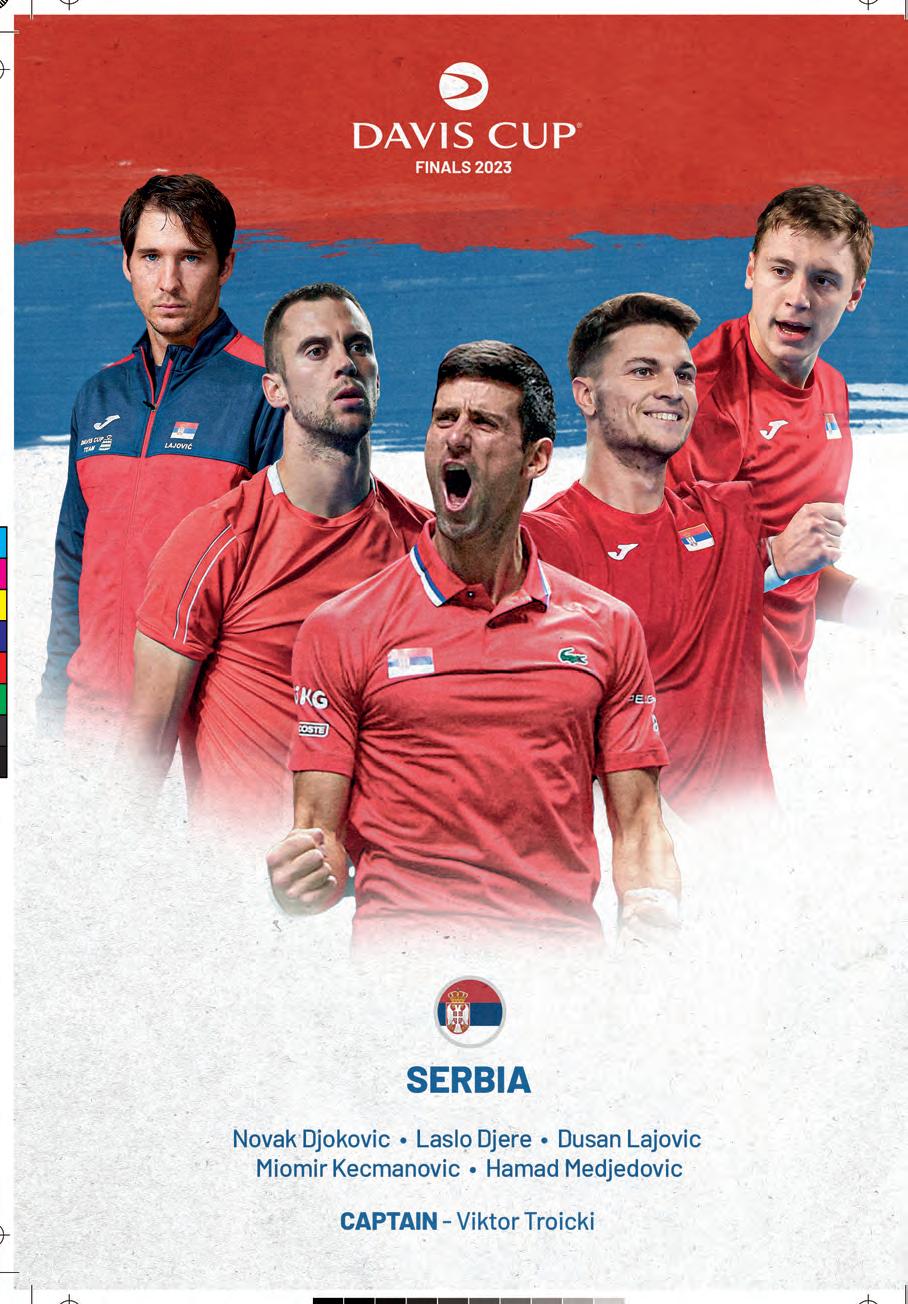
Serbia conquered all before them and proved themselves to be the best team on the planet in 2010 when they won their fist – and so far only – Davis Cup title.
Serbia defeated USA, Croatia and Czechia to reach the 2010 finalwhere France lay in wait. What unfolded was a pulsating finalin Belgrade which went the distance and was decided by the fifth mtch of the tie.
Novak Djokovic had already chalked up two singles wins, the latter hauling Serbia level after they trailed 2-1 following the doubles, which paved the way for Viktor Troicki to land the knockout blow.
In December 2020, Troicki was appointed Serbia’s Davis Cup captain, and he guided his nation to the semi-finalsof the competition in 2021 where Croatia intervened and ended hopes of a second triumph.




THE DAVIS CUP FINALS HAVE ARRIVED IN MALAGA. HERE’S EVERYTHING YOU NEED TO KNOW ABOUT ONE OF SPAIN’S MOST
With a population of 579,076 in 2022, Malaga is the second-most populous city in the Andalusia region of Spain and the sixth most populous in the country.
Malaga’s history dates back around 2,800 years, making it one of the oldest continuously inhabited cities in Western Europe.
The legend suggests Malaga was founded around 770 BC by the Phoenicians from
Tyre and they named the area Malaka, with the journey taken by the region since those beginnings adding to the cosmopolitan mix we see today.
Picasso’s Birthplace Museum
Pablo Picasso, the most important painter of the 20th century, was born in Malaga in 1881 at number 15 Plaza de la Merced. Declared a Historic-Artistic
https://mediacenter.costadelsolmalaga.org/book-malaga
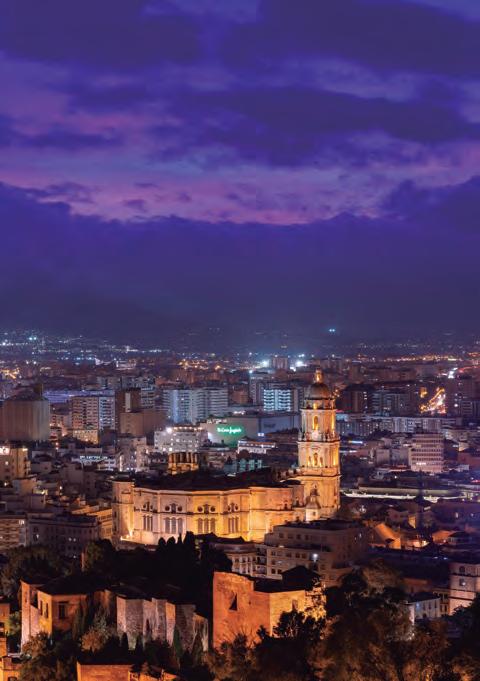
Monument of National Interest in 1983, Picasso’s Birthplace Museum fist used only the fist floor but ow occupies the entire building. The building where Pablo Picasso was born in 1881 and lived until 1884 houses works and personal belongings of the artist and his family. A library and an on-going program of temporary exhibitions and cultural activities further add to the experience.
In the past few years, Malaga has become a favourite choice for the world’s top museums, which have settled in town to show their collections to visitors from around the globe. These museums showcase the works of the old masters and contemporary artists alike, and attest to Malaga’s international flai.
Picasso museum
The Museo Picasso Malaga was inaugurated in 2003, in response to Pablo Picasso’s wish for a place in his native city where his work could be shown to society.
The institution has since become fundamental to understanding the rich development of the local culture. The museum is both a landmark and a magnet, not to mention symbolic for anyone living in the capital of the Costa del Sol. Those drawn to Malaga from all parts of the world by the talent and fame of the legendary, locally-born painter are able to learn at close hand about his life and work.

Offering a selection of masterpieces, the Centre Pompidou boasts a wide programme of exhibitions and multi-disciplinary experiences as well as exhibitions and workshops dedicated to younger audiences. The aim is to become an interface between society and creation,
and to make today’s art accessible to as wide an audience as possible.

Carmen Thyssen Museum Malaga
The permanent collection rooms at the Carmen Thyssen Malaga Museum offer a journey through Spanish art of the 19th and the early 20th centuries, with special emphasis on Andalusian landscape painting and traditional scenes. The works belong to Baroness Carmen Thyssen’s private collection – more than 200 pieces, including a fie selection of works of the Old Masters (13th to 18th centuries).
La Alcazaba Fortress
This fortress palace, whose name in Arabic means citadel, is one of the city’s historical monuments and is much visited because of its history and beauty.

The building that dates from the Muslim period is located at the foot of the Gibralfaro hill, crowned by the Arab defence works to which the Alcazaba is connected by a walled passage known as the Coracha. With the Roman Theatre and the Aduana Customs Building, this special corner offers the chance to observe Roman, Arab and Renaissance culture, all within a few yards of each other.
El Teatro Romano
Malaga’s Roman theatre remained hidden underground for many centuries, but the ancient architecture is now a must-see attraction for any tourist.
The site also has a Centro de Interpretación (visitor centre) which provides visitors with a guide about the history of the ruins and its subsequent excavation.

The Cathedral
Its full name is Nuestra Señora de la Encarnación (Our Lady of Incarnation) although in Malaga it is simply known as “the Cathedral”. Cathedrals are important in all cities, but in Malaga it is even more important than usual. It is not only a religious building but a national landmark,
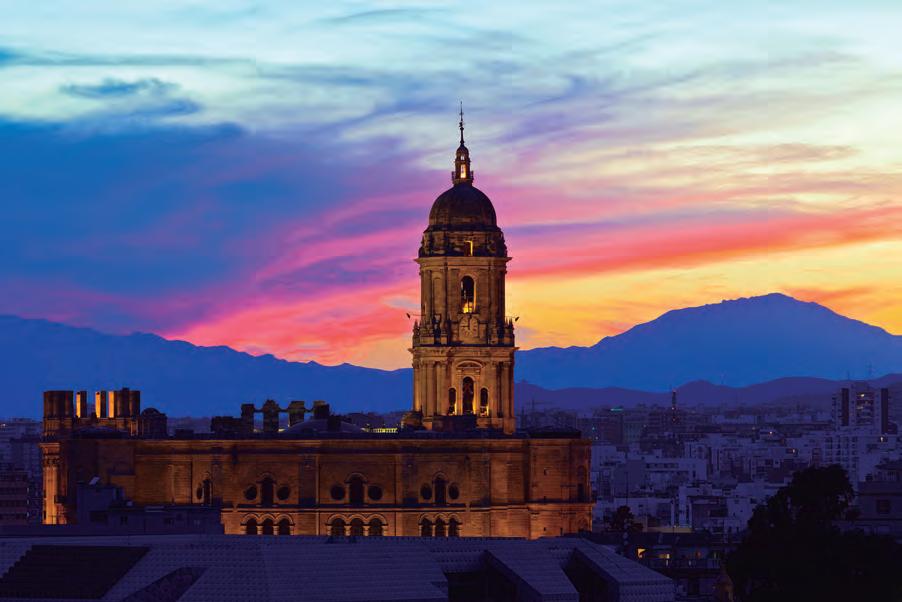
a milestone along the road and a witness to many events.
The building is one of the best examples of Spanish religious art and it is located on the remains of other cultural buildings such as the early Almohad mosque.
The main street in Malaga is considered by many to be the most elegant in Spain

and dates back to the 19th century. While the facades of the buildings look similar along Calle Larios, it is worth taking a closer look as you will see different details in the moulding in each building.
The Marquis of Casa Loring conceived the La Concepción Botanical-Historical Garden around 1855 and it remains an impressive landmark to this day.
With a sizeable open-air collection of tropical and subtropical floa, it hosts more than a thousand species and was declared a historic artistic garden in 1934.
It is currently a Property of Cultural Interest (BIC) and has been renovated since Malaga City Council acquired the property in 1990.
Sea and mountains leave their mark on the vast number of flvours that trans-

late into culinary dishes and creations that, sprinkled with the exquisite wines of this land, will delight casual and foodie travellers alike. To discover the cuisine of Malaga is to immerse yourself in its culture and history.
The maritime tradition has inspired Malaga’s recipes for centuries. The Mediterranean, which shapes the identity of this city on the Costa del Sol, is the source of dishes that are recognisable to any palate, from the already internationally renowned skewers to a noodle casserole or Malaga prawns. Every bite of a seafood dish takes you on a far-reaching tour of the city through its flvour: fry-up, skewered fis, fresh seafood from the bay and much more.
The most popular menus in chiringuitos offer pescaíto frito (fried fish), safood
dishes or salads with local products. Eating in a chiringuito means tasting Malaga’s flvours from the sea while breathing the sea breeze and savouring fresh fish fom the bay.
Skewers, and more specifically te sardine skewers (espetos de sardinas), are a Malaga cuisine classic. One of the most appreciated delicacies by locals and tourist and one of the most demanded specialties in beach bars and restaurants on the extensive coast of Malaga. Malaga sardine skewers have become a sign of cultural identity.
On your trip to Malaga you must try an ‘espeto’ (sardine skewer) right off the grill at one of the ‘chiringuitos’ (beach bars).
If you have ever been to Malaga, you have surely seen the “espeteros” grilling fish
over the coals in boats on the beach. This tradition dates back to the 19th century and has been preserved until today, sardine espetos have become symbolic of Malaga’s cuisine.
If there is one thing that really defies Malaga, it is its ability to share. Getting together with friends or family and ordering some tapas or servings is part of Malaga’s culture par excellence, and the perfect way to try a little bit of everything.
From the most traditional dishes, like Malaga salad or anchovies in vinegar, to those with innovative nuances like Malaga sausage tartar. In any case, going out for tapas is a common theme at any time of the year. More than a way of eating, it’s a way of living and enjoying the flvours of Malaga in good company.
Ajo Blanco
A cold soup that features garlic, skinned almonds, bread, olive oil, salt and vinegar. This mix is blended and poured into a small glass or bowl.
When the soup is fully mixed in the blender, it’s poured into a small glass or bowl and sometimes served with sliced melon or grapes.

The Palacio de Deportes José María Martín Carpena is an impressive venue that has a capacity of 11,300 for sporting events and is the home of the Baloncesto Malaga basketball team.
As well as being a magnifient sporting arena, it has also hosted music concerts featuring Tom Jones and Supertramp.
This venue has a long tradition of hosting major tennis events, with the semi-finals of the 2003 Davis Cup (featuring hosts Spain and Argentina) staged here, as well as the annual ITF Masters Tour event that takes place each November.





The Davis Cup Finals Group Stage took place in September in four different cities: Bologna, Valencia, Split and Manchester. Passion, excitement, tennis at its highest level, surprises, comebacks and lots of vibrant colours filled the courts for six days. The top two teams in each group booked their tickets for the Davis Cup Final 8 in Malaga.
Team Canada: It might sound strange that one of the more surprising storylines from the Group Stage was that reigning champions Canada made it through to the Final 8. But captain Frank Dancevic couldn’t call on an injured Denis Shapovalov and the team was without Felix Auger-Aliassime so it was left to the relatively unknown Gabriel Diallo and Alexis Galarneau, both of whom delivered some astonishing wins against higher-ranked opposition to book Canada’s place in the quarter-finals

Team Italy: After an initial slip-up in their opening tie against Canada, Italy turned to another newcomer, Matteo Arnaldi, and he set the tone for an Italian revival that saw them sneak past Chile in second place in Bologna. The fact that the Italians, who were without both Jannik Sinner and Matteo Berrettini, still made it through to the Final 8 should send a message to the rest of the teams in Malaga that they are ones to watch.

Team Great Britain: The last nation to confirmits place in the Final 8 was Great Britain, who faced France in a winner-takes-all clash on the last day of the Group Stages. Dan Evans delivered a point in singles and doubles alongside Neal Skupski as GB clinched a three-set thriller in front of the biggest British Davis Cup crowd in history. Leon Smith was also able to call on contributions from newcomer Jack Draper and veteran Andy Murray as his team battled to three good wins from three difficult ts.

Team Australia: Last year’s runners-up are looking to go one better in 2023, but only advanced from a competitive Group B in Manchester in second place. Lleyton Hewitt’s team were defeated 2-1 by Great Britain in their opening tie, but proceeded to pick up a 2-1 win against France before sweeping Switzerland 3-0.

Team Czechia: Considering the Czechs were drawn in a group that included both Spain and Serbia, it might sound surprising that Jaroslav Navratil’s team were the only side to emerge from the Group Stages with an unblemished record of nine wins from their nine matches played. Jiri Lehecka led his side with three wins in singles, but the Czechs didn’t put a foot wrong, with every one of their four-man team contributing to the points total. They are not to be taken lightly in Malaga.

Team Serbia: Doubtless the arrival of Novak Djokovic straight after winning his 24th Grand Slam title at the US Open and returning to No. 1 in the world stole most of the headlines in Valencia, but the 36-year-old was actually only responsible for winning one of Serbia’s six points. Viktor Troicki’s men dispatched Korea, Republic 3-0 before the arrival of Djokovic and then swept Spain by the same scoreline once he had set foot in town. With Laslo Djere looking back to his best, they have a solid No. 2, but still look like there are weaknesses in doubles. At least that’s what other teams will be hoping to exploit.

Team Netherlands: The Dutch counted themselves unlucky last year to lose a close quarter-finalagainst Australia and this year it looks like they mean business once again with three wins putting them top of Group D in Split. With strength in singles and doubles, the Dutch are a tricky team to beat and, despite not having any Top 20 players in singles, they have shown for the second straight year that they are a team to avoid in the Group Stage.

Team Finland: Another fairytale story as Finland stunned USA and Croatia to book their place in the Final 8 for the fist time in history. Emil Ruusuvuori is the best-known Finnish player, but it was Otto Virtanen who announced himself with three wins in his three singles matches as Finland came through in second place in Split.
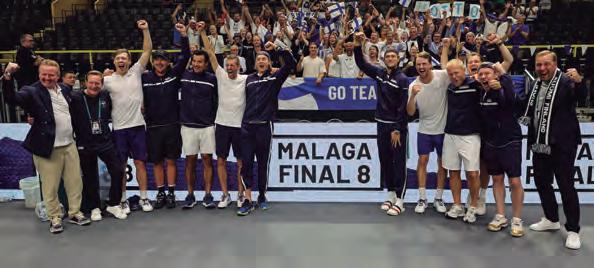
Andalucia is a privileged destination for the practice of all sports. The splendid weather conditions and the quality of its sports facilities make Andalusia the preferred place to hold sporting activities and events.

All sports can be practiced in the area: water sports, golf, horse riding, nature, team and individual sports for adults and children. No other place in Spain offers so many opportunities for sport. Add to this the cultural and tourist attractions that Andalusia has to offer all year round,
and our region is an excellent choice for tourism and sport.
The region is also the focus of top-level competition, with major events of international importance that are important tourist attractions and elements of
tourism promotion for the region. Every year, Andalusia offers an impressive range of events that thrill sports enthusiasts.
There is no other region in Spain with more days of sunshine throughout the year, with more golf courses, with mountains, water and city sports, etc., and with sports facilities that are the envy of the rest of Spain, both in terms of quality and quantity.
In addition, in the heart of the Penibetic system is the Sierra Nevada, a unique place with the highest ski resort in Spain and the southernmost in Europe. It is home to the highest peaks in the Iberian Peninsula, Veleta and Mulhacén, and is only 100 kilometres from the Mediterranean Sea and the Tropical Coast. In the Sierra Nevada, you will fid more than a hundred kilometres of ski runs, divided into 115 pistes, and an impeccable infrastructure of ski lifts and services that make this resort an incomparable place to enjoy winter sports.
And if golf is your passion, Andalusia is the best region in Spain to play this
sport. The unbeatable climate means you can play golf all year round. The courses are located in privileged areas, with landscapes of great beauty or close to paradisiacal beaches. With around a hundred courses to choose from in all the provinces, whatever your level, there is no shortage of driving ranges, pitch and putts, 9-hole and 18-hole courses, as well as a wide variety of surfaces adapted to the most varied geographical environment.
In this sense, Andalusia is the perfect destination for the tourist-sports binomial, where you can come and practise sport in all its forms while enjoying the incomparable gastronomy, history and hospitality of its people.
Andalusia is also one of the most important tourist destinations in the world. Its range of hotels, gastronomy, rich historical and cultural heritage and beaches make it one of the most attractive regions in Europe for the millions of Spanish and foreign tourists who choose to spend their holidays here every year.

Quality and safety make the region the most attractive place in southern Europe: modern hotels, cities and towns full of history and monuments, national parks and natural areas that will surprise those who visit them for the fist time, and gastronomy capable of satisfying the most demanding palates.
To all this must be added a culture based on authentic roots, the legacy of the many peoples who have populated it and left their mark in folklore, music, literature, art and hundreds of manifestations that extend from the capitals to the most remote areas of this land.
Andalusia has something to always satisfy all the needs of the traveller. It has an enviable climate that makes it possible to visit all year round, a vast territory full of contrasts, 1,000 kilometres of coastline, the southernmost ski resort in Europe and the largest protected natural area on the continent.
Andalusia has beaches that surprise us with the variety of their landscapes, from the wide beaches of fie sand in the provinces of Cadiz and Huelva to


the hidden coves between the cliffs on the coast of Granada, Costa del Sol and Almeria. Andalusia’s beaches also offer a wide range of services. Marinas, golf courses, promenades, open-air sports grounds, boat moorings and restaurants make Andalusia an ideal destination for sun and beach tourism or water sports.
Andalusia’s cultural wealth will take you back to the earliest times, with important archaeological sites, and the legacy of the different cultures and civilisations that settled in this beautiful and rich land in southern Spain. The Alhambra in Granada, the Mosque of Cordoba and the Giralda in Seville are monumental landmarks of Humanity, an immense artistic legacy inherited from a millenary history that will delight the traveller.


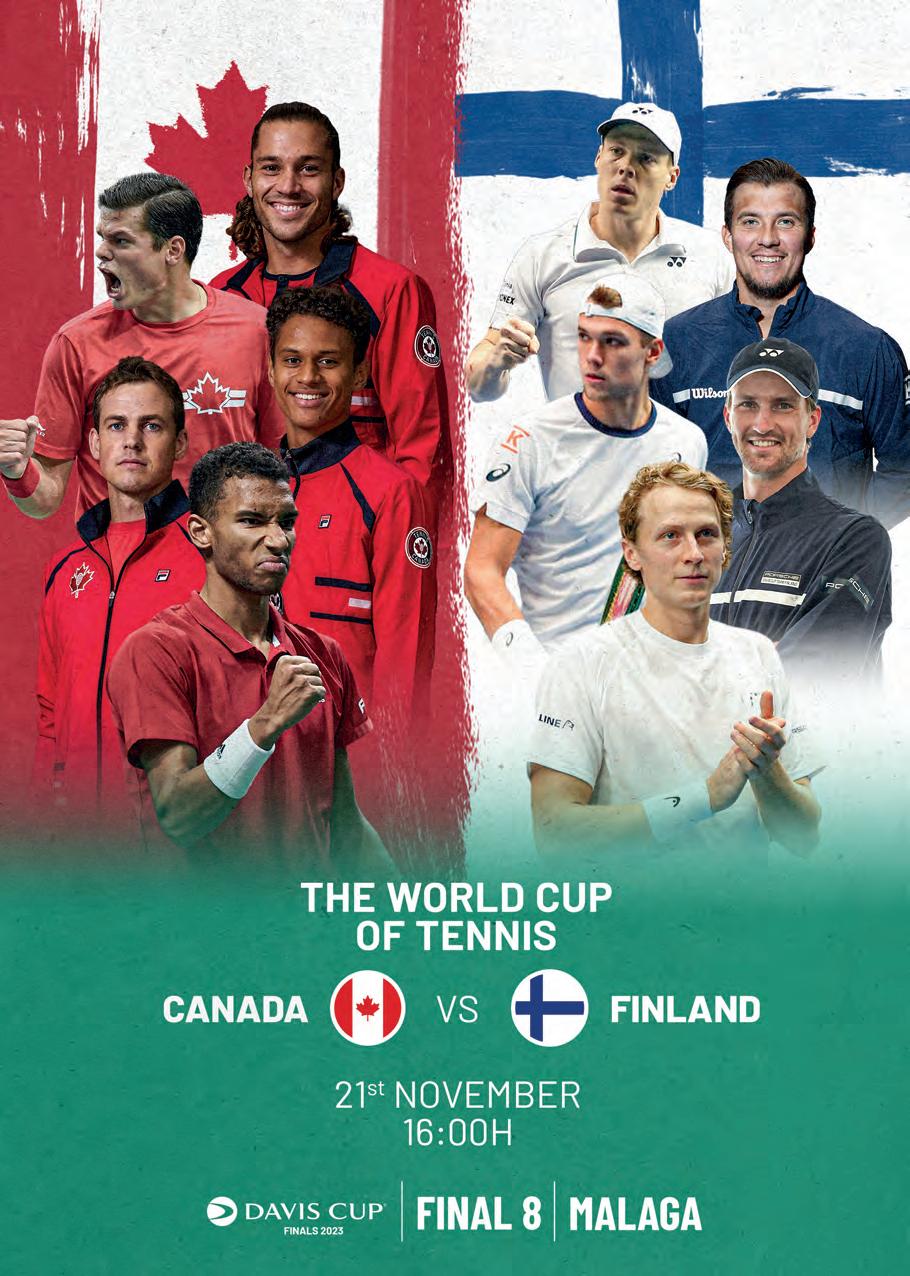

While the Davis Cup Finals Group Stage sometimes requires complex calculations to work out which teams will advance, things are far more simple for the Final 8 knockout stage. The winners will take it all.
For defending World Champions Canada, a victory against the Finns on the opening day in Malaga would see Frank Dancevic’s team through to the semi-�nals for the second straight year, and for the third time in four Davis Cup seasons, having finised runners-up to Spain in 2019 as well as their title-victory in 2022. Their Group Stage exit at the 2021 Finals remains the sole aberration in an otherwise gloriously successful half-decade of Canadian Davis Cup history.
Canada’s group-topping performance in Bologna at the Finals Group Stage in September was made all the more impressive given their top two players’ struggles with injury and form this season. Felix Auger-Aliassime did not compete in September (although he returns for the Final 8) and has endured a difficul year – from a career-high ranking of No. 6 at the beginning of 2023, he now faces a battle to end the season inside the world’s Top 20. Denis Shapovalov, meanwhile, has not played since Wimbledon due to a knee injury, and while he was part of the team in Bologna, he is set to miss the action in Malaga.
But such challenges also present opportunities – and so it was that Gabriel Diallo and Alexis Galarneau stepped up from
their supporting roles to guide the Canadian team to victories over Italy, Chile and Sweden, ably assisted by the veteran Vasek Pospisil. The Canadians lost just one of nine matches they played during the Group Stage, and will be keen to bring that form to Malaga.
For Finland, meanwhile, the only way is up – by securing their place among the Final 8, Jarkko Nieminen’s team have already achieved their nation’s best-ever Davis Cup performance. They are the only fist-time Davis Cup quarter-finaists in Malaga and, knowing they have nothing to lose, will be determined to continue the feel-good vibes from their victories over Croatia and USA in Split in September.
Emil Ruusuvuori and Otto Virtanen have both enjoyed solid seasons, and were in impressive form at the Finals Group Stage, while in Harri Heliovaara, the Finns have an elite doubles player who
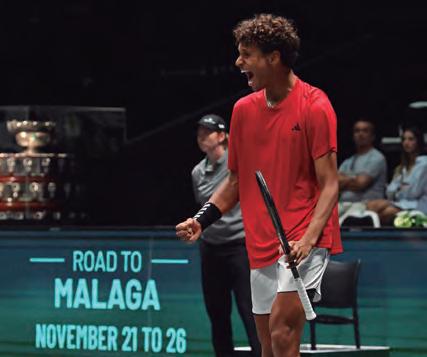

will be tough to beat should the tie go to a deciding doubles match, regardless of who his partner is.
This will be just the second Davis Cup match-up between Canada and Finland – but it will, without doubt, be their most high-profile clas. The nations’ only previous encounter in the competition came 57 years ago in Helsinki, with Canada winning 4-1 on an outdoor clay court.
The return of the aforementioned Auger-Aliassime, who won the the decisive second point of the 2022 final, will liely generate considerable interest. Canadian captain Dancevic will have a selection dilemma on his hands – stick with Galarneau and Diallo in singles, which proved to be a winning formula in Bologna, or add Auger-Aliassime into the mix?
Canada’s team for the Final 8 also includes Milos Raonic, the former world No. 3 and 2016 Wimbledon finalist, wose battles with injuries in recent years have restricted him to just four tournaments in the last two seasons. Raonic has not made a Davis Cup appearance since 2018 – what a story it would be if he was able to make a comeback as part of another title-winning team.
For Finland, expect captain Nieminen to back Virtanen and Ruusuvuori in singles again – but perhaps his most difficu decision will be to select a partner for Heliovaara should the tie go to a decisive doubles match. Heliovaara has played at least one Davis Cup match alongside Ruusuvuori, Patrik Niklas-Salminen and Patrick Kaukovalta this year, and has enjoyed a good year on tour too, winning the US Open mixed doubles title alongside Kazakhstan’s Anna Danilina in September.



A place in the 2023 Davis Cup semi-finals awaits the winner, but there is so much more on the line than that.
Czechia, the only team with a perfect 9-0 win-loss record at the Group Stage in September, can also lay claim to being one of the youngest squads at this year’s men’s World Cup of Tennis.
Czech skipper Jaroslav Navratil is no stranger to this competition having led his team to consecutive victories back in 2012 and 2013. The fact that his team progressed from a group that included Serbia and Spain would have been enough to turn a few heads, but doing so
in such a comprehensive fashion speaks volumes about this team’s attitude.
Australia, by contrast, were made to work very hard for their place in the Final 8 in Malaga, but Lleyton Hewitt’s fighting spirit seem to live on in his current crop of Davis Cup players, who did enough to make it through despite losing to Great Britain in Manchester.
Last year’s runners-up will be determined to show that they have what it takes to go all the way in this competition – having not lifted the Davis Cup trophy since 2003.
Both nations have a proud Davis Cup history, with Australia having won the
competition 28 times in total and the Czechs having three titles to their name.
The Australians have certainly got the better of their Czech counterparts in previous encounters between the two teams, winning eight of their nine Davis Cup clashes.
Czechia’s only victory came way back in 1975 when, competing as Czechoslovakia, Jan Kodes inspired his team to a 3-1 win. The Czechs would go on to reach their fist Davis Cup final, alling to Sweden.
The teams have met three times since then, including their most recent encounter in 2017, which was just Hewitt’s second tie as Aussie captain.
Arguably the biggest surprise for Czechia was just how well 18-year-old Jakub Mensik handled his Davis Cup debut at the Group Stage in Valencia.
The 6ft 4ins teenager partnered Adam Pavlasek to victories in doubles against Spain and Korea, Republic before sweeping past Serbia’s Dusan Lajovic in straight sets in his first singles appearance.
The Czech duo of 21-year-old Jiri Lehecka and 23-year-old Tomas Machac might not be known outside of tennis aficiondos but, despite their youth, both have plenty of experience of playing for their country and showed just how dangerous they are back in September.
Australia’s Alex de Minaur always brings his A-game when playing in the green and gold and with a current ranking of No. 13 in the world will be the highest-ranked player in this encounter.
Elsewhere, Hewitt has plenty of options for his second singles player, and in Matthew Ebden he has one of the best doubles players in the world to call on should it go down to the wire.




Cervezas Victoria reinforces its commitment to sport by continuing the sponsorship agreement it signed last year with the Davis Cup. The Davis Cup is a mythical tournament where top players take a break from their personal schedules to play for their country. This major event will take place in Malaga over the next few days and will feature the world’s best tennis players. Thus, the Malaga beer becomes the Official Beerf the Davis Cup Finals for 2022 and 2023, which will be held from 19th to 23rd November at José María Martín Carpena Sports Arena.
Sport is in Cervezas Victoria’s DNA, and since its beginnings it has shared the values of self-improvement, effort and teamwork, which is why its name has appeared as a sponsor at countless sporting events. The brand will be present in its home city of Malaga, for the Finals in November, and was present during the Group Stage in September in four venues - Bologna, Valencia, Manchester and Split.
The history of Cervezas Victoria has been linked to Malaga’s history since its beginnings. On 8th September 1928, the day of the Virgen de la Victoria, patron
saint of the city, the fist Victoria brewery opened in the popular neighbourhood of El Perchel, in the city of Malaga. Victoria was born with the determination to pursue excellence and went in search of it where the best beer was produced: German machinery and master brewers join the Malaga-based brand’s attitude.
Over the years, Victoria beer has become the locals’ favourite beer, who have taken the slogan “Malagueña y exquisita” (exquisite and from Malaga) as their own and have turned the character on the label, known as ‘the German’ of Victoria, into one of Malaga’s icons.
For this reason, Cervezas Victoria has remained strongly linked to the city, becoming increasingly popular year after year. On 7th September 2017 it opened its current brewery in Malaga, a space open to the city and a cultural meeting point where the different varieties of Cervezas Victoria are brewed and can be visited by booking via its website. A 100 % beer experience awaits: a 90-minute tour where you will learn fist-hand the secrets of the “Malagueña y exquisita” Victoria beer and enjoy a beer tasting and pulling workshop.

A place in the Davis Cup semi-finals, pue and simple. Both Netherlands and Italy emerged from the Davis Cup Finals Group Stage but there is no margin for error here – the tournament has reached its business end and this is knock-out tennis.
Netherlands are being touted as dark horses for the 2023 Davis Cup title and for the second successive year – and only the second time since 2005 – they have reached the quarter-final stag. There is a real sense that something is building.
Should they dispatch Italy, Netherlands will equal their best Davis Cup performance which came in 2001 when a team featuring current captain Paul Haarhuis fell to eventual champions France after defeating Spain and Germany.
Italy, on the contrary, are no strangers to Davis Cup semi-finals ad 12 months ago they were in striking distance of their fist final sice 1998 before running into a buoyant Canada and the irrepressible Felix Auger-Aliassime.
The Italians have reached six semi-finals this century and have finised as Davis Cup runners-up on six occasions, but have only one title to their name, which was way back in 1976. Getting to the latter stages would not appear a problem, it is those final ew steps.
There is not a huge amount of comfort for Netherlands when looking at their past record against Italy in Davis Cup having lost their previous seven ties against their Final 8 rivals.


However, it is not all doom and gloom as the Dutch do have one win to their name against the Italians in the competition – a 5-0 triumph on the clay of Noordwijk in 193.
There is nothing to say that the past has to dictate the future and, in any case, there has only been one meeting between the two nations since the 1970s and that was more than a decade ago in 2010.
On that occasion, Simone Bolelli claimed two singles victories as Italy triumphed 4-1 in a Europe/Africa Group I showdown in Zoetermeer. Most of Italy’s past victories over Netherlands have been convincing, but this is very much a new era.
Italy showcased their remarkable strength in depth during September’s Davis Cup Finals Group Stage in Bologna as they emerged alongside defending
champions Canada, leaving Chile and Sweden trailing in their wake.
Matteo Arnaldi announced himself in national team colours with singles victories in ties with Chile and Sweden, having made his competition debut in the doubles against Canada. Lorenzo Sonego followed suit to underline his quality.
Both players will be on show in Malaga as will world No. 22 Lorenzo Musetti and the returning Jannik Sinner, who was absent for the Group Stage. Having the world No. 4 bolster your ranks can be no bad thing and Sinner is most definiely worth keeping a close eye on.
Netherlands do not have the luxury of such a highly-ranked player but they are a well-oiled machine, with Tallon Griekspoor and Botic van de Zandschulp both very tricky customers and a match for anyone. In short, it promises to be a fantastic quarter-final ti.


History, national pride and a semi-final spot at the 2023 Davis Cup Finals - the men’s World Cup of Tennis - is all on the line in arguably the blockbuster tie of the four quarter-final clases in Malaga.
Ten-time champions Great Britain, seeking their fist Davis Cup semi-final in our years, face a Serbia side led by world No. 1 Novak Djokovic. The Serbs are looking to lift the title for the second time following a memorable 2010 triumph that resulted in the entire team shaving their heads in celebration.
Djokovic has made winning the Davis Cup his top priority for the remainder of 2023, setting up an intriguing week in which the world No. 1 will try and carry the Serbian team to glory (reminiscent of the manner in which Andy Murray dragged the Brits to a remarkable triumph in 2015).
The chances of a 37th edition of Djokovic v Murray on the singles court aren’t hugely likely, given each team’s highest-ranked player will face off in the tie’s second match and Murray is currently the British No. 3, but let that take nothing away from the occasion.
Great Britain, on their part, now have a team bursting with depth – all fie of their squad enjoyed crucial victories during the Davis Cup Finals Group Stage in Manches-
ter, and they will likely all need to play a part again if the Brits are to go all the way.
Serbia, too, have singles depth with four players ranked inside the world’s Top 60, but their lack of doubles prowess is where they have fallen short in recent years. That remains the obvious chink in their armour in this format.
Serbia (who assumed Yugoslavia’s record for historical purposes) have edged this match-up in the past, winning fie of their nine previous meetings.
They have faced the Brits just twice in the last 36 years though and, as you may expect, Djokovic proved the difference in both of those encounters.
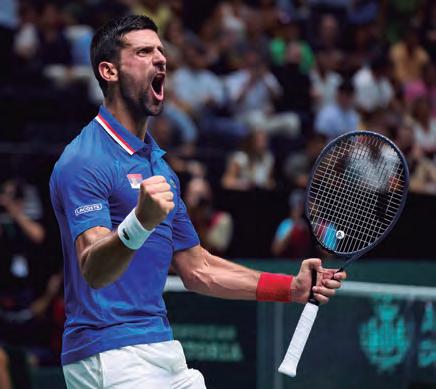
In 2006, the super Serb won both of his matches to guide Serbia to a 3-2 victory in Glasgow, while in 2016 his absence from the team proved equally pivotal. Kyle Edmund stood up to the occasion in Djokovic’s home city, winning both of his singles matches against Janko Tipsarevic and Dusan Lajovic to help the visitors to a 3-2 triumph in the quarter-finals in Belgade.
Not for the fist time, the majority of eyes will be on Djokovic. The 36-year-old will likely play in both singles and doubles, should the deciding match be required, and the 24-time Grand Slam champion will know he needs to improve his form when sharing the court if Serbia are to be genuine title contenders.
Djokovic has won just four of the 11 Davis Cup doubles matches he has contested and perhaps even more worryingly for
Serbia, he is on a four-match losing streak at tour level in doubles (if discounting the contest he won alongside Matteo Berrettini in Laver Cup back in 2022).
The Brits, on the other hand, have strong doubles options. Dan Evans and Neal Skupski proved both a formidable and resilient pairing in September, pulling off the mother of all comebacks to beat France and book their spot in Malaga. Evans, however, is sidelined for the Final 8 due to injury. Fortunately for the Brits they have another strong doubles performer in Joe Salisbury.
Andy Murray, of course, is a very good doubles player too, and when you factor in their singles options – with Cameron Norrie, Murray and rising star Jack Draper, captain Leon Smith has both weapons and options at his fingetips.



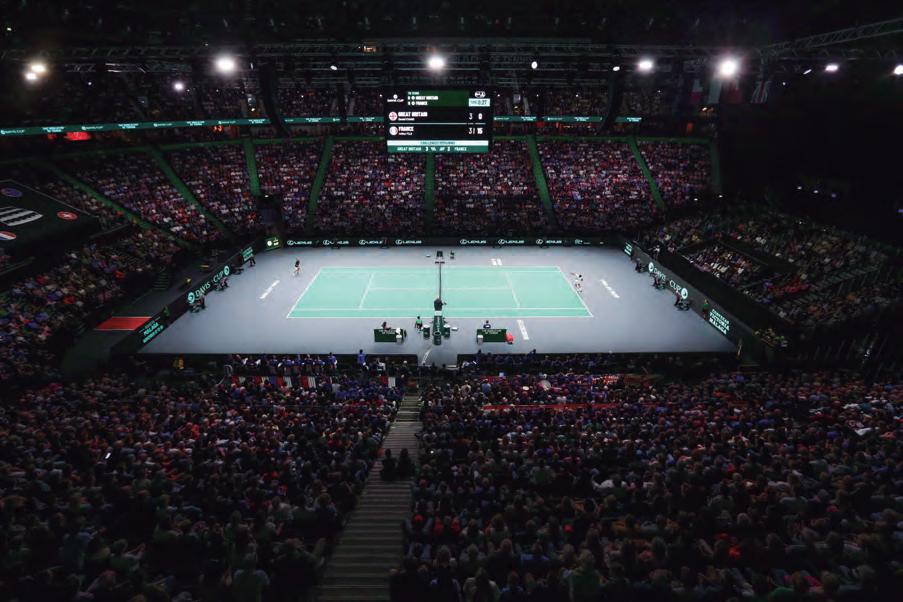
Here’s your guide to the remarkable history of the Davis Cup competition, and what lies in wait as the eight nations that have reached the 2023 Davis Cup Final 8 prepare to battle it out for the most prestigious prize in men’s team tennis.
The Davis Cup is the ultimate team event in men’s tennis, with the history of this competition stretching back to 1900.
The concept of the competition was dreamed up a year before it kicked off, as four members of the Harvard University tennis team devised a plan to stage a match between the USA and their British counterparts.
That fist match took place at the Longwood Cricket Club in Boston, with the USA beating opponents playing under the name of the British Isles.
Initially named the International Lawn Tennis Challenge, the name Davis Cup was quickly put in place after one of the four players who came up with the idea for the competition, Dwight Davis, designed the format and paid for the trophy with his own money.
It was an investment that ensured his name would be synonymous with elite tennis for a century and more.
The Davis Cup quickly expanded from a two-nation event to a tournament welcoming players from around the world as in 1905, France, Austria, Belgium and Australasia, a combined team of players from Australia and New Zealand, entered the fray.
The USA, Great Britain and Australasia won the early editions of the Davis Cup until France ended that monopoly in 1927.
Led by their ‘Four Musketeers’ – Jean Borotra, Jacques Brugnon, Henri Cochet and Rene Lacoste – the French side won six successive Davis Cup titles through to 1932.
By the time the Open Era started in tennis in 1968, more than 50 nations were competing and in 2023, 156 nations participated in the Davis Cup.
The nations competing in the 2023 Davis Cup Final 8 earned their place in the draw after coming through the Group Stage in September.
Ties took placed across four cities - Bologna, Manchester, Split and Valencia - on 12-17 September, with two nations emerging from each group.
Defending champions Canada won Group A in Bologna, with Italy securing the second spot in that pool.
There was high drama in Manchester as hosts Great Britain secured a thrilling win against France in a deciding set tiebreak. Australia sealed the other qualifying spot up for grabs in that group.
Czechia and a Serbia side

C in Valencia and there were shocks in Split, as outsiders Netherlands and Finland overcame USA and hosts Croatia to seal their place in Malaga.
The eight teams will compete in a knockout competition, with two singles and one doubles match deciding each tie.
The action will kick-off on Tuesday 21 November 21 at 4pm as captain Frank Dancevic leads Canada into battle against Jarkko Nieminen’s Finland, the lowest-ranked team (14th) to participate in Malaga.
Day two will feature Czechia’s match against Australia, with Lleyton Hewitt’s Aussies looking to end a 20-year wait to win what would be their 29th Davis Cup title.

There will be two matches on Thursday 23 November as Italy take on the Netherlands in the opening match of the day at 10am.
Then the quarter-finals will onclude with Novak Djokovic’s Serbia taking on Great Britain.


Joma 1968


The story of Joma could be told as a long-distance race, where its founder, Fructuoso López, always had a clear goal in mind. A trajectory of effort, dedication, and above all, overcoming, which has resulted in one of the leading brands in the global sports market and the main one at a national level.
But to know the origins of Joma, one must travel back to the year 1965, to a small town in the province of Toledo. There, Fructuoso decided to start warming up by producing sports footwear with the help of only eight employees. In just four years later, the Joma Sport S.A. brand was firmly orn, with the creation of a new factory and an increase in the workforce. Although the real turning point came in the 80s, when the current headquarters of 65,000 m2 with automatic assembly lines and over 300 employees were inaugurated.
Joma Sport was now more than ever a reality, an economic engine that brought life and put Portillo de Toledo on the map. But there was still another burst of
speed to give. The destiny still had more in store. Since the establishment of the new headquarters, Joma began signing athletes of those times, such as Emilio Butragueño, José Luis González, Alfonso Pérez, or Morientes, marking milestones such as the incorporation of color into football footwear. The fist subsidiaries were also opened in Mexico (1996), the United States (1999), and Italy (2002).
After this great sprint, Joma’s pace has been growing faster and faster, reaching to present day with eight subsidiaries in the United States, Italy, China, UK, Germany, Mexico, Panama, and Brazil, and with a presence in the market of over 120 countries. A prominence that has positioned itself as the Spanish brand with the highest sales volume in the world and in the international top ten. And this success is no longer just the result of a job well done, but of the values that the company has always kept true.
Quality, commitment, and technology guide Joma every day and in all its sponsorships. That is the main reason why
athletes, teams, federations, and even various Olympic committees proudly wear the famous J on their official uforms today. In addition, being present in a wide range of sports disciplines: from football and athletics, its cradle sports, to tennis, paddle tennis, handball, volleyball, or basketball.
Specificall, in tennis, more and more people want to get on board or, as Joma calls its family of athletes, join the #JomaTeam. Over the past few years, it has been creating a huge team of tennis players and federations from different parts of the world, getting closer and closer to the leadership positions.
Currently, it is the officialechnical sponsor of the Royal Spanish Tennis Federation, the Italian Tennis and Padel Federation, the Serbian Tennis Federation, and the Slovak Tennis Federation. These last two additions have taken place in recent months, a fact that serves to understand the frenetic pace at which Joma is moving. Similarly, the long-distance race that Fructuoso

started in the 60s has led to the world and national tennis number ones wanting to join #JomaTeam. Among them are Pablo Carreño, Feliciano López, Marcel Granollers, Sara Sorribes, and Albert Ramos; or Beatriz Haddad, Marco Cecchinato, Ivan Dodig, Marie Bouzková, and Tomáš Macháč among the international players.
Furthermore, Joma’s corporate blue has reached the most emblematic tennis tournaments in the world. To give a brief overview, there is the Rome Masters 1000, the most prestigious tournament on clay courts. There, in 2023, Joma equipped all ball boys/girls and set up a sales stand of over 250 m2. As a curiosity and to get an idea of the revolution that the Spanish brand has undergone in such a short time, this space is just half the size of Joma’s fist factory in the 60s.
Another milestone achieved this year has been the sponsorship of the Davis Cup Finals, which has served as a great showcase to the world thanks to the clothing provided to the technical team, the members of the #JomaTeam who made it there, and Feliciano López, brand ambassador at this event. The special bond that unites Joma and Feliciano López dates back to 2008 and goes beyond a sponsorship agreement. The brand and the tennis player share roots and a passion for sports, something that has been evident during these years with the trusting relationship that has endured well beyond his retirement.
In a nut-shell, Joma’s history is full of challenges, obstacles, a true test of overcoming upheld by effort and commitment to a family that goes beyond the limits of Portillo de Toledo.



The Davis Cup Final 8 has arrived in Malaga and the eight nations that will do battle for the biggest prize in men’s team tennis will create a new slice of history as the oldest competition in the sport crowns its latest winner

The fist Davis Cup took place in 1900 as USA took on Great Britain, then playing under the name of the British Isles.
In the 123 years since that ground-breaking match, the greatest names in tennis have fought to get their nation’s name on the trophy, with this year’s Final 8 enjoying some particularly standout moments that stirred the hearts of sports lovers around the world.
We recap their best bits to date in the men’s World Cup of Tennis.
Champions: 28 times - 1907, 1908, 1909, 1911, 1914, 1919, 1939, 1950, 1951, 1952, 1953, 1955, 1956, 1957, 1959, 1960, 1961, 1962, 1964, 1965, 1966, 1967, 1973, 1977, 1983, 1986, 1999, 2003

Australia will be looking to build on a proud record in this competition, as they are the second-most successful nation in Davis Cup history behind USA.
Lleyton Hewitt was the leader of the team the last time Australia lifted the title in 2003, with his thrilling fie-set win against

Spain’s Juan Carlos Ferrero in the 2003 Final in Melbourne a moment to savour for a player who has always relished the challenge of representing his country.
Hewitt was also a pivotal figue in Australia’s 1999 Davis Cup win, with Mark Philippoussis taking centre stage to win his two singles matches in the Final against France. Hewitt has the most singles wins (42) and the most total wins for Australia in the competition (59).
The most successful player for Australia in the Davis Cup is Roy Emerson, who won the title on eight occasions, while Australia’s Harry Hopman holds the record as the most successful captain with 16 wins.
Champions: 2022

Canada’s greatest Davis Cup moment came a year ago, when they beat Australia in the Final to claim their fist title.
The names of Denis Shapovalov and Felix Auger-Aliassime will forever be etched into the annuls of Canadian tennis folklore after they won a tense quarter-final against Germany and backed that up by beating Italy in the semi-finals efore sealing a win against Lleyton Hewitt’s Australia team in the Final.
Such a moment of glory seemed improbable for Canada throughout much of its history in the Davis Cup, with the nation that fist played in the competition in 1913 boasting a losing record over the last century.
The history books confirm tht a Canadian player owns a piece of history that will never be erased, as Harry Fritz played in the longest Davis Cup singles match in terms of the number of games (100). Fritz beat Venezuela’s Jorge Andrew 16-14 11-9 9-11 4-6 11-9 in 1982.

Champions: 1980, 2012, 2013


The Czechs will always cherish their fist Davis Cup triumph, as a team led by the indomitable Ivan Lendl won the title with a thrilling win against Italy in Prague.
That victory also included an epic semi-�nal triumph away in Argentina, as they overcame a team featuring local hero Guillermo Vilas to win in Buenos Aires.
Radek Stepanek and Tomas Berdych were their heroes 22 years later, as the Czech side claimed a second Davis Cup crown with an impressive victory against a strong Spain side in Prague before they backed up that success by retaining the trophy a year later with victory over Serbia in the Final, despite two singles wins for home favourite Novak Djokovic in Belgrade.
Best performance: Reaching the 2023 Final 8

Finland created history by sealing their place in the Davis Cup Final 8 in Malaga, with tennis lovers across the nation toasting the achievements of Emil Ruusuvuori and Otto Virtanen as they found a way through a challenging Group Stage that saw them beat Croatia and a powerful USA team.
After making a fist appearance in the Davis Cup in 1928, Finland’s best previous performances came as they reached the World Group play-offs in 1990, 1999 and 2002.
The name of Jarkko Nieminen dominates the Davis Cup record books for Finland as he has the most total wins (63), most singles wins (48) and the most ties played (35). He will also lead Finland into the Final 8 as Finland captain in Malaga.



Italy’s run to glory in the 1976 Davis Cup was one of the great moments in their nation’s tennis history.
After coming through a tight contest against Great Britain, played on the No. 1 Court grass at Wimbledon, a team led by Adriano Panatta set their sights on glory heading into a semi-�nal against Australia in Rome.
Panatta won the decisive match of that tie against Australia’s John Newcombe before the team travelled to Chile and wrapped up Italy’s fist and so far only Davis Cup title by winning the fist three matches of the Final.
Best performance: 2001 Semi-final

It was a case of what might have been for the Netherlands in the 2001 Davis Cup.
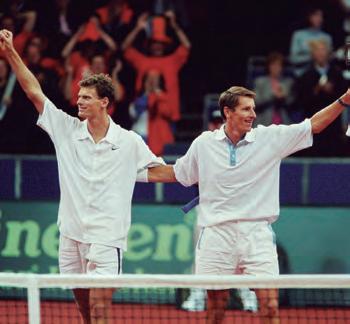
After coming through ties against Spain and Germany in impressive fashion, France lay in wait in a semi-final plyed in front of a passionate crowd in Rotterdam.
Raemon Sluiter’s failure to complete his match against France’s Arnaud Clement due to injury was a major factor in the final oucome, with Sjeng Schalken then losing out in an epic fie-set contest against Nicolas Escude.
Defeat in the doubles gave France a win that paved the way for them to lift the title against Australia in the Final.
Champions: 10 times - (1903, 1904, 1905, 1906, 1912, 1933, 1934, 1935, 1936, 2015)

After playing in the fist Davis Cup tie 123 years ago, Great Britain enjoyed great success in the competition, with the legendary duo of Fred Perry and Bunny Austin guiding them to a run of successes in the mid-1930s.
That proved to be their last period of sustained success in the Davis Cup, with their appearance in the 1978 Final ending in defeat against a John McEnroe-inspired USA.
It needed some majestic performances from Andy Murray to end their 79-year wait to lift the trophy once again as they beat Belgium in a Final played in Ghent.
Great Britain is the only nation that has participated in all the editions of the Davis Cup from 1900, playing in 264 ties ahead of their appearance in Malaga.

Champions: 2010

Serbia made their debut in the competition in 1995, competing as Yugoslavia between 1995 and 2003, and as Serbia & Montenegro between 2004 and 2006.
Their greatest moment came in 2010, when an inspired Novak Djokovic led his team to glory in front of a euphoric home crowd in Belgrade.

Serbia’s run to the title included a win against a strong American side, as Djokovic won a deciding fifth st against John Isner to seal the tie, with a comeback win against Czechia in the semi-finals stting up a date with France in the Final.
All who were present for that encounter in Belgrade will never forget the emotion it stirred, as Djokovic and Viktor Troicki won crucial matches on the final day to clinch victory.

Malaga is an Andalusian city on the shores of the Mediterranean Sea and close to the Atlantic Ocean. It is Spain’s sixth-largest city by population. The city is surrounded by a metropolitan area that brings the city’s population close to one million inhabitants. It is all set in a mild climate, enjoying plenty of hours of sunshine.
The city boasts a rich and diversified historical legacy. Malaga has managed to combine its age-old traditions with
the modernity that makes it a city at the forefront of tourism and technology.
Its exceptional connectivity enhances this situation. Malaga-Costa del Sol Airport is the third most important airport on the Iberian Peninsula. In turn, the cruise terminal is currently a landmark on the Mediterranean route for ships, as it is just a stone’s throw from the city’s old town centre. Finally, the high-speed rail connection and motorways to the north,


east and west, round off a perfectly connected destination for short, medium and long distances.
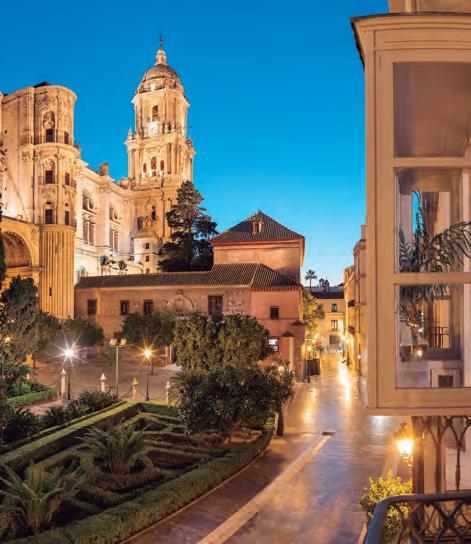
The key to boosting its potential was Malaga’s commitment to culture, to the point that today the city is considered a benchmark in this regard.
The city’s wide range of museums and exhibitions, which now number around fift, with fist-class venues such as the Picasso Museum Malaga, the Museum of Malaga, the Carmen Thyssen Museum and the Centre Pompidou Malaga, is proof of this.
This wide range of museums is complemented by the millennial city’s own artistic and cultural legacy, as refleced in the Roman Theatre, the Muslim Alcazaba, the spectacular Renaissance Cathedral, the numerous Baroque temples, the architecture and the 19th-century urban planning in the old town centre. The old quarter has been restored and pedestrianised, making it ideal for taking a stroll through the city.

As for culture, we cannot forget to mention Pablo Ruiz Picasso, who has put Malaga on the cultural map of the world, with continuous references to his native city. This has been supported by Malaga’s involvement and status in the fiftith anniversary of his passing - the Picasso Celebration 1973-2023.
However, Malaga has also managed to add value to other tourist sectors by offering authentic, local experiences. Gastronomy is one of the strengths in this regard. Initiatives from both the public and private sectors have meant that Malaga is now one of the most highly rated places for gastronomic tourism. This is due to the variety on offer and the projection of culinary talent through numerous world-renowned chefs and establishments.

A combination of culture, gastronomy and art has also given rise to the development of other types of tourism such as lifestyle, shopping and premium tourism. Fashion brands, creators, and ultimately, talent land in Malaga in response to a friendly, open and cheerful destination, where Malaga’s personality and citizens’ way of life is one of its main keys to success.
Malaga’s locals enjoy the streets, share their traditions, are proud of their city and are not afraid to show it, explain it and share it with visitors. This hospitality is particularly evident in the local celebrations, such as the authentic Semana Santa (Easter) processions in the middle of spring, the Feria de Agosto (August Fair), Carnival and Christmas, when the

city is lit up and full of life and entertainment in is magical streets.
The steady increase in all manner of facilities and services has also made Malaga stand out in terms of MICE tourism and congresses. The Trade Fairs and Congress Centre and the hotel infrastructure mean that more than 400 national and international professional events covering all types and topics will have been held by 2022.
These facilities also make it possible to host major sporting events. Malaga has successfully demonstrated its capacity to host numerous major international events and is a strong host for the Davis Cup Final 8.
Furthermore, Malaga has emerged as a great city to settle down to work. As
such, the city fosters both local talent and attracts and retains talent and productive investment. The city’s vibrant business fabric, university life, cultural heritage and the fact that it is a Smart City benchmark make Malaga a prized location, not to mention its commitment to quality and sustainable tourism. By distributing and diversifying its resources, Malaga acquired a prominent position in Europe. Nowadays, Malaga is sought after by a sustainable, cosmopolitan visitor profil, who seeks culture, leisure and gastronomy on their trips. Overall, the city has embraced Smart Tourism Destination pillars which include accessibility, technology, sustainability, governance and innovation.
Together, these make Malaga the perfect city to visit, live and invest alike. It’s the perfect place to be.

Among the 38 players taking part in the Davis Cup Final 8, there are:
• 6 players who have won at least one Davis Cup title during their careers* – Felix Auger-Aliassime, Gabriel Diallo, Novak Djokovic, Alexis Galarneau, Andy Murray, Vasek Pospisil
• 2 Grand Slam men’s singles champions – Novak Djokovic, Andy Murray
• 7 Grand Slam men’s doubles champions – Simone Bolelli, Matthew Ebden, Thanasi Kokkinakis, Wesley Koolhof, Vasek Pospisil, Max Purcell, Neal Skupski
• 4 Grand Slam mixed doubles champions – Matthew Ebden, Harri Heliovaara, Wesley Koolhof, Neal Skupski
• 2 players who have won an Olympic medal – Novak Djokovic, Andy Murray
• 1 player who could make his Davis Cup debut this week – Gijs Bouwer
• 5 players who made their Davis Cup debuts in 2023 – Matteo Arnaldi, Jack Draper, Patrick Kaukovalta, Hamad Medjedovic, Jakub Mensik
6 3 2 2 1 1 1 11 5 7 4 4
• 3 lefthanders – Gijs Bouwer, Jack Draper, Cameron Norrie
• 1 player who won the Davis Cup Juniors title – Felix Auger-Aliassime (2015)
• 11 players aged 30 or over – Simone Bolelli (who, at 38 years 49 days**, is the oldest player competing this week), Novak Djokovic, Matthew Ebden, Harri Heliovaara, Wesley Koolhof, Dusan Lajovic, Andy Murray, Vasek Pospisil, Milos Raonic, Joe Salisbury, Neal Skupski
• 4 players aged 21 or under – Jack Draper, Hamad Medjedovic, Jakub Mensik (who, at 18 years 86 days**, is the youngest player competing this week), Lorenzo Musetti
• 1 player who celebrates a birthday during the Davis Cup Finals – Matthew Ebden (who turns 36 on Sunday 26 November)
*defied as having been a nominated player in a team that won the Davis Cup Final
**ages calculated on final dy of the tournament
***participating players as of 6 November
Of the 8 teams, there are:
6 7 3 2 2 2 1 4
• 6 teams which have previously won at least one Davis Cup title –Australia, Canada, Czechia, Great Britain, Italy, Serbia
• 4 teams which have been ranked No. 1 on the Davis Cup Nations Ranking – Australia, Canada, Czechia, Great Britain
• 3 teams with multiple players aged 30 or over – Canada (who have 2), Great Britain (3), Serbia (2)
Of the 8 captains, there are:
• 7 captains who competed in the Davis Cup as players – only Leon Smith did not
• 2 captains who won the Davis Cup title as a player – Lleyton Hewitt, Viktor Troicki
• 2 captains who have won the Davis Cup title as a captain – Frank Dancevic, Leon Smith
• 1 captain who won a Grand Slam men’s singles title – Lleyton Hewitt
• 2 captains who won a Grand Slam men’s doubles title – Paul Haarhuis, Lleyton Hewitt

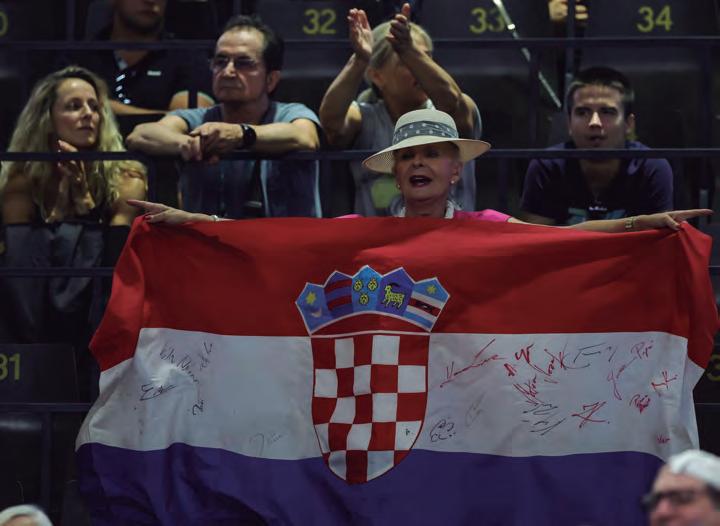






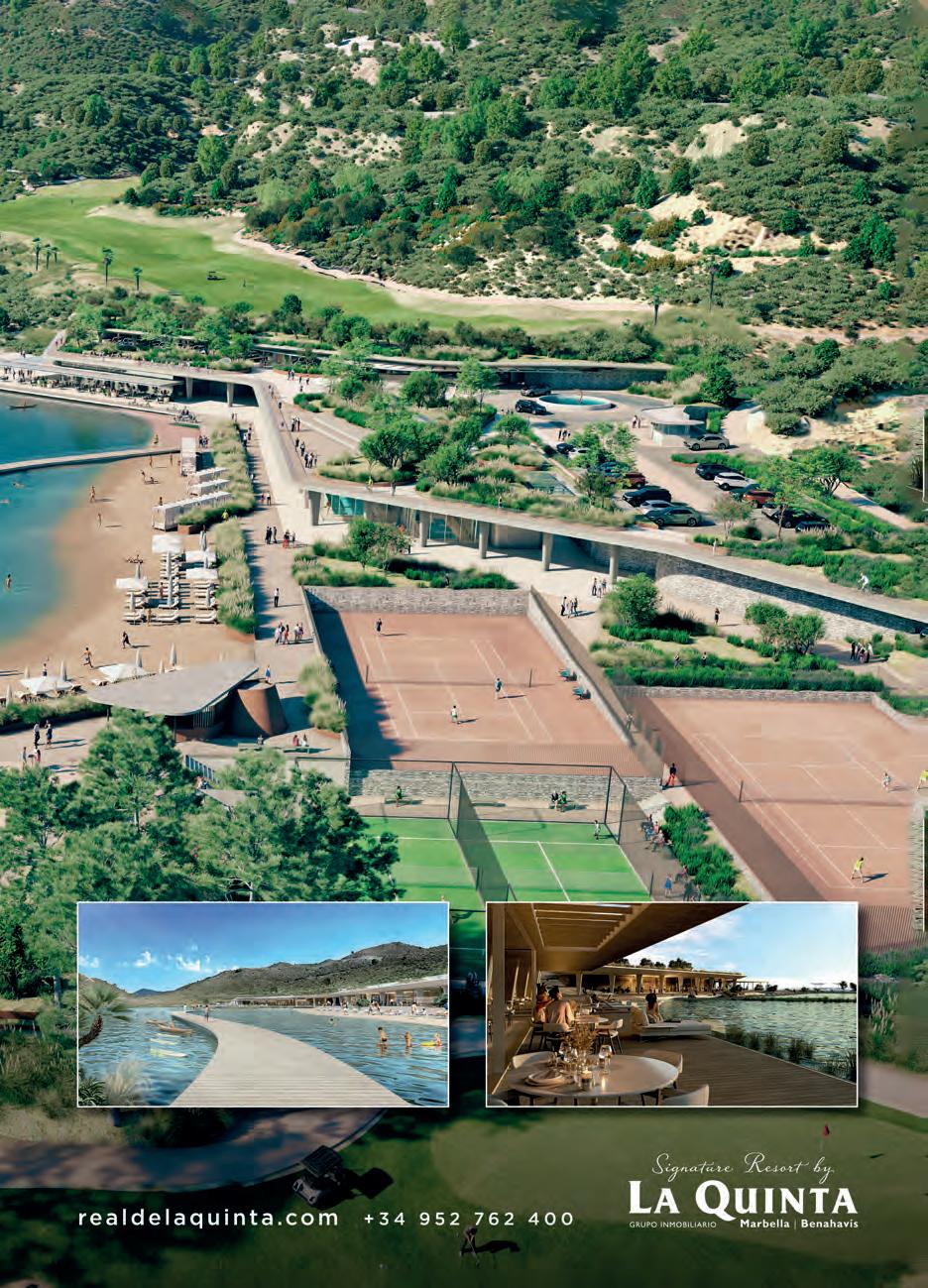


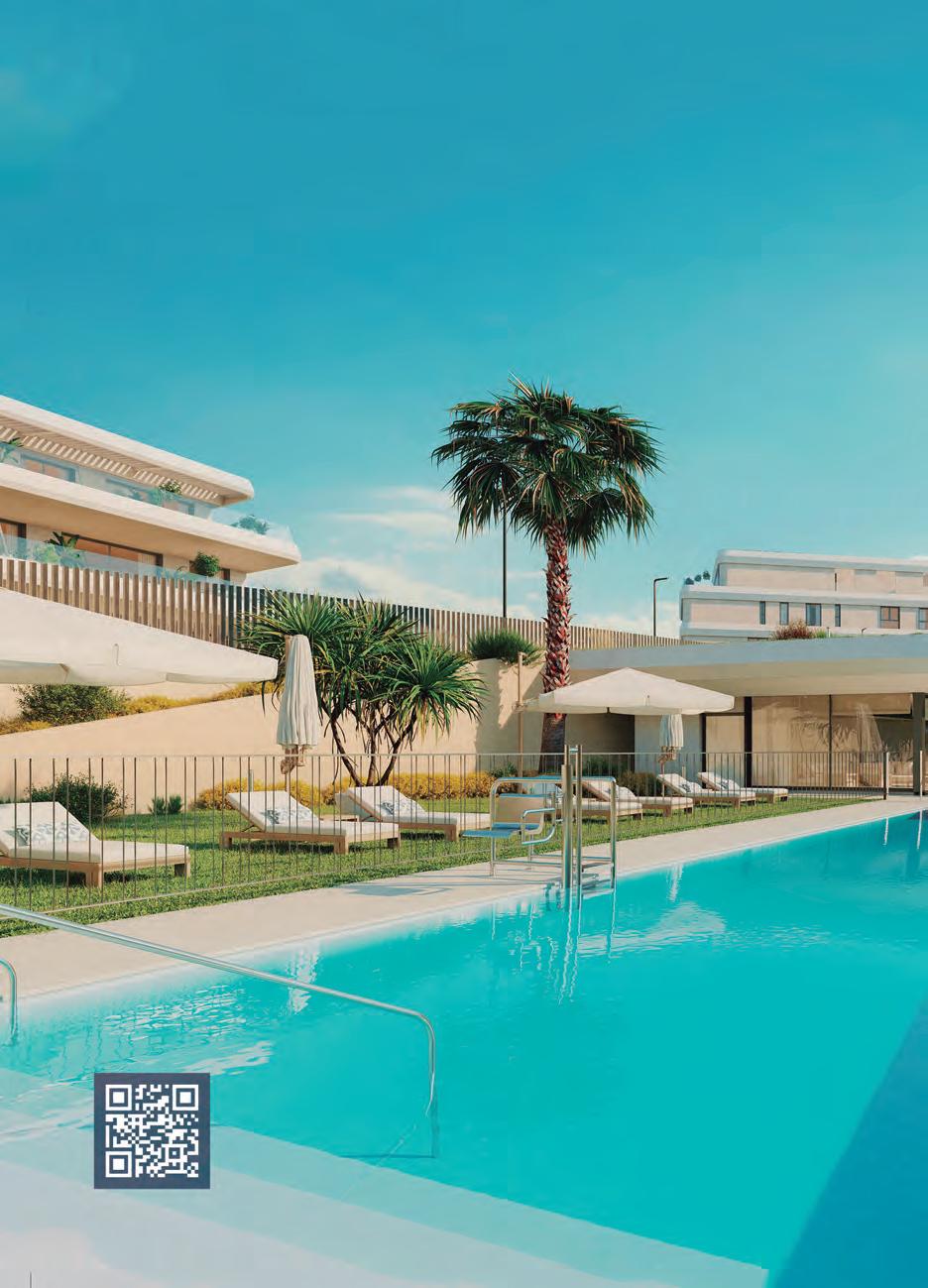










































A sign of the times

FEITO FRANCÉS
MILLARES
RIVERA
SAURA SERRANO SUÁREZ VIOLA
EXPOSICIÓN TEMPORAL Temporary exhibition CANOGAR CHIRINO
Museo
Casa Botines Gaudí LEÓN
DAVIS CUP
Final 8 Malaga
November 2023
Writers & Contributors
Joanne Burnham
Ross McLean
Tom Moran
Kevin Palmer
Ed Pearson
Jamie Renton
Photography
@ ITF Tennis Asset Bank
@ Ayuntamiento de Málaga
@ Diputación de Málaga
@ Junta de Andalucía
@ Malaga City Tourist Board
Creative Director
Judit Budó
Graphic Designer
Marcel Pedrola
Nacho Saenz
ITF Senior Executive Director, Communications
Heather Bowler

Editorial Production
Editorial MIC

